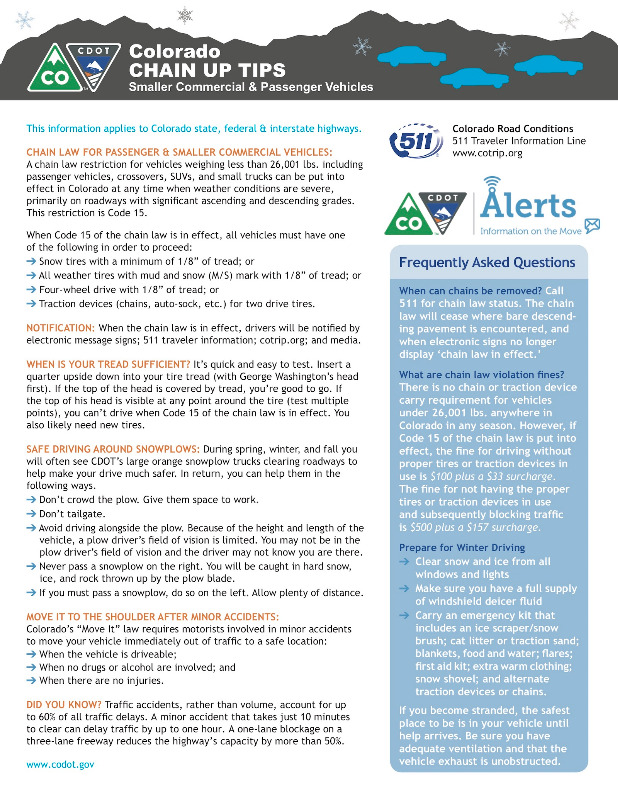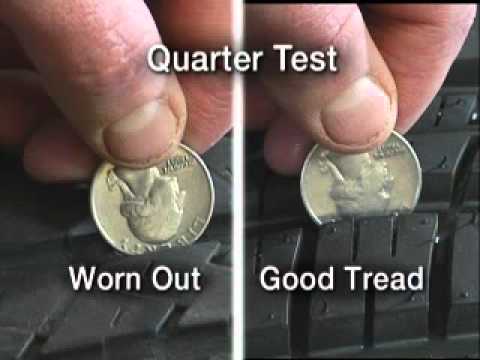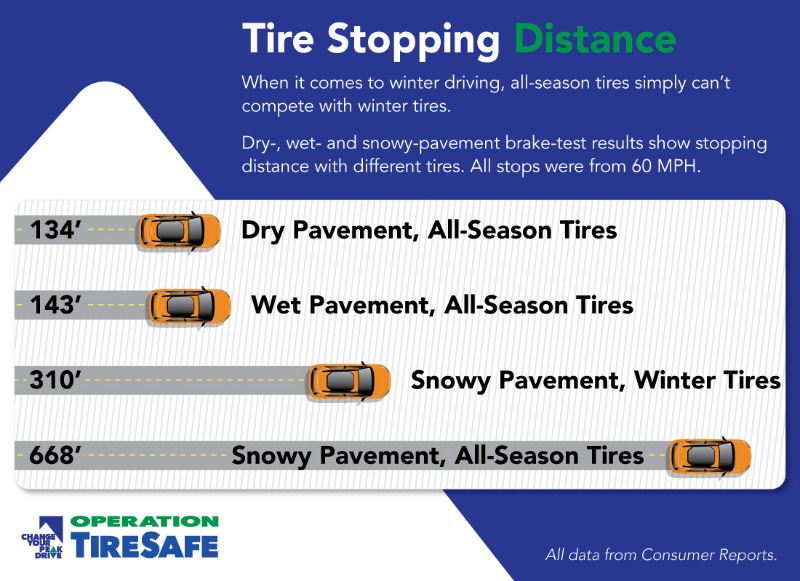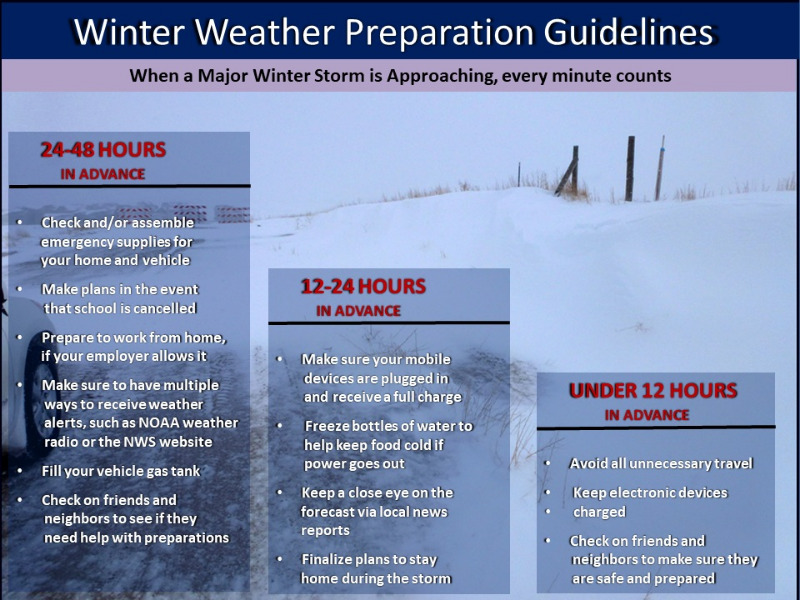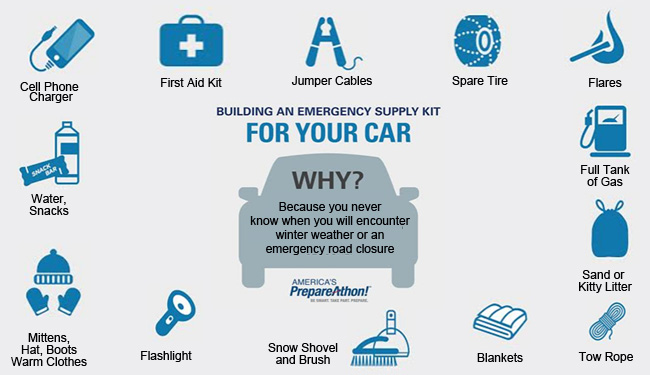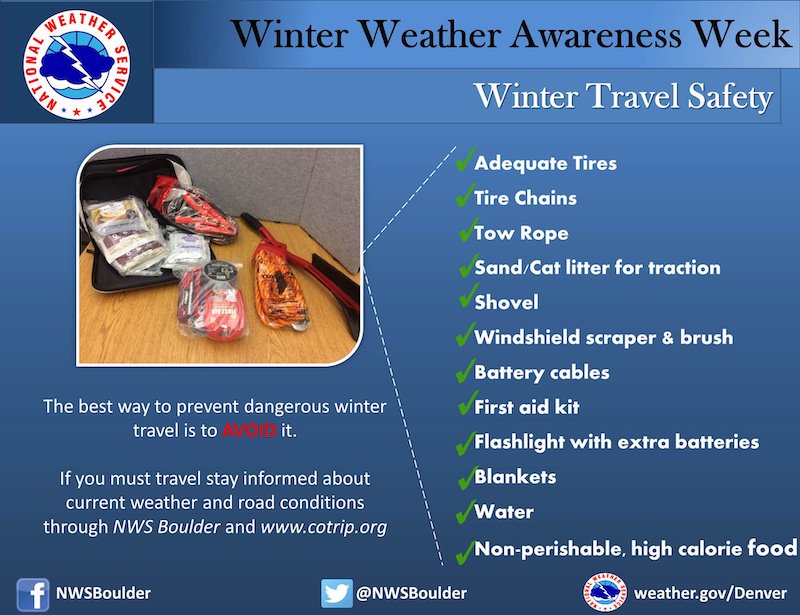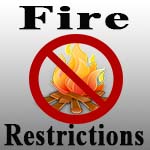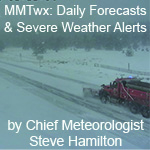- Posts: 9579
- Thank you received: 219
- Forum
- Life Up the Hill
- Scanner & Emergency Info, Weather Forecasts
- Preparing for Winter in the Mountains
Preparing for Winter in the Mountains
- MountainTownAlerts
-
 Topic Author
Topic Author
- Mountain Legend
-

Colorado Winter Weather Awareness & Travel Safety from Ready.gov
Winter Weather Preparedness by Weather Underground
9 Things You Need to Do Now to Prepare for Winter
By Mikey Rox on 7 November 2014
Make sure you keep your home, health, and sanity intact by taking the following preventative measures now.
- Slowly Condition Your Home to Cooler Temperatures
- Kick Rodents and Other Pests to the Curb
- Stock Up on Your Outdoor Hardware
- Clear Vents and Chimneys to Avoid Carbon Monoxide Mishaps
- Take Preventative Measures Against Pipe Freezing
- Visit Your Doctor or Local Pharmacy for a Flu Shot
- Outfit Your Car for Winter Weather
- Replace Shingles and Clean Your Gutters
- Consider the Well-Being of Your Mind and Body
These steps, most of which you can do yourself, will help lower your utility bills and protect your investment.
- Tune Up Your Heating System
- Reverse Your Ceiling Fans
- Prevent Ice Dams
- Hit the Roof
- Caulk Around Windows and Doors
- Clean the Gutters
- Divert Water
- Turn Off Exterior Faucets
- Drain Your Lawn-Irrigation System
- Mulch Leaves When You Mow
- Prepare to Stow Your Mower
- Don't Prune Trees or Shrubs Until Late-Winter
- Test Your Sump Pump
- Call a Chimney Sweep
- Restock Winter Essentials
Preparing for Winter - Tree Health
Colorado has a wildly unpredictable winter. We can see temperature swings of forty to sixty degrees in just twenty-four hours. Winter can be either incredibly dry, or wet and snowy. Also, Colorado has over three hundred sunshine-filled days per year, meaning that during winter the sun can be shining bright and warm, but the temperature can still be freezing. All these conditions mean that Colorado tree owners need to take special steps to prepare for winter. Water in winter, wrapping the trunk, and fall fertilization can all help tackle water.
Please Log in or Create an account to join the conversation.
- MountainTownAlerts
-
 Topic Author
Topic Author
- Mountain Legend
-

- Posts: 9579
- Thank you received: 219
From Sept. 1 through May 31, all commercial vehicles traveling on I-70 between the Edwards exit (mile point (MP) 133) and the Morrison exit (MP 259) must carry sufficient chains to be in compliance with the Colorado chain law.
Colorado Chain Law Frequently Asked Questions
Chain Up Tips for Passenger & Small Commercial Vehicles
Colorado Chain Law Fact Sheet (2015) from Silverthorne.org
Colorado's new I-70 traction law in effect from September to May
Author: Erin Powell, 9News | Published: August 30, 2019
DENVER — Attention, drivers who use Interstate 70: Colorado’s new winter traction law goes into effect on Sunday and lasts for nine months.
The law, signed by Gov. Polis in May 2019, said vehicles need to either have snow tires or carry some sort of traction device (like chains or tire socks) at all times if they’re not four-wheel drive or all-wheel drive. The rule applies to the stretch of I-70 between Dotsero and Morrison, and it’s in effect from Sept. 1 to May 31, regardless of the forecast.
The new law also increased the minimum tire tread requirements to three-sixteenths of an inch.
CSP Trooper Gary Cutler told 9NEWS drivers should be aware that severe weather conditions can lead to stricter regulations.
Please Log in or Create an account to join the conversation.
- MountainTownAlerts
-
 Topic Author
Topic Author
- Mountain Legend
-

- Posts: 9579
- Thank you received: 219
New Campaign, Operation TireSafe, Calls on Coloradans to Check Tires Before Driving to Mountains
How do you know if you need new tires? The Quarter Test is a quick and easy way to assess if your tires meet the minimum tread depth (one-eighth-inch) during a Traction Law.
- Insert a quarter into the tire tread upside down, with Washington's head going in first.
- If the top of George's head is covered by the tread, your tires are OK. Do this test at multiple points around each tire.
- If the top of his head is visible at any point around the tire, your tires won't meet the Traction Law minimum, and you should consider new tires.
Suggestions on how to winterize your car include:
- Battery and ignition system should be in top condition and battery terminals clean
- Ensure antifreeze levels are sufficient to avoid freezing
- Ensure the heater and defroster work properly
- Check and repair windshield wiper equipment; ensure proper washer fluid level
- Ensure the thermostat works properly
- Check lights and flashing hazard lights for serviceability
- Check for leaks and crimped pipes in the exhaust system; repair or replace as necessary
- Check breaks for wear and fluid levels
- Check oil for level and weight - heavier oils congeal more at low temps
- Consider snow tires, snow tires with studs or chains
- Replace fuel and air filters - keep water out of the system by using additives and maintaining full tank
- Remember to keep a winter weather emergency kit in your vehicle, just in case...
- Extra clothing, such as blankets, coats, hat and gloves
- Shovel
- Flares and jumper cables
- Water and foods, such as trail mix and snacks
Driving safely on icy roads:
- DO NOT PASS snow plows or sand trucks in operation!!!
- Allow extra time for any travel
- Decrease speed - stopping on ice and snow requires greater distance
- Brake gently to avoid sliding or skidding
- If your brakes do lock up, ease up on the brakes to regain traction
- Use lower gears in poor conditions to maintain traction
- Be careful when crossing bridges/overpasses as they will ice faster than roadways
www.readycolorado.com/blog/winter-weather-travel-safety
Please Log in or Create an account to join the conversation.
- MountainTownAlerts
-
 Topic Author
Topic Author
- Mountain Legend
-

- Posts: 9579
- Thank you received: 219
Before the storm strikes, make sure your home, office and vehicles are stocked with the supplies you might need. Make sure farm animals and pets also have the essentials they will need during a winter storm. Know how to dress for varying degrees of cold weather.
–At Home and Work
Your primary concerns at home or work during a winter storm are loss of heat, power and telephone service and a shortage of supplies if storm conditions continue for more than a day. In either place, you should have available:
- Flashlight and extra batteries
- Battery-powered NOAA Weather Radio and portable radio to receive emergency information
- Extra food and water such as dried fruit, nuts, granola bars and other food requiring no cooking or refrigeration.
- Extra prescription medicine
- Baby items such as diapers and formula
- First-aid supplies
- Heating fuel: refuel before you are empty; fuel carriers may not reach you for days after a winter storm
- Emergency heat source: fireplace, wood stove or space heater properly ventilated to prevent a fire
- Fire extinguisher, smoke alarm; test smoke alarms monthly to ensure they work properly
- Extra pet food and warm shelter for pets
- Review generator safety: Never run a generator in an enclosed space
- Make sure your carbon monoxide detector is working correctly and that the outside vent is clear of leaves and debris. During or after the storm, make sure it is cleared of snow.
- Home fires are common each winter when trying to stay warm. Review ways to keep your home and loved ones safe.
–In Vehicles
Each year, on average, more than 5,000 people are killed and more than 418,000 are injured due to weather-related vehicle crashes. If you need to drive in snow or cold conditions, TAKE IT SLOW IN THE SNOW. Black ice can be difficult to see. If the temperature is near freezing, drive like you're on ice--you may be!
Before you leave the house, especially before a longer trip in winter, make sure all fluid levels are full and ensure that the lights, heater and windshield wipers are in proper condition. Keep your gas tank near full to avoid ice in the tank and fuel lines. Avoid traveling alone. Let someone know your timetable and primary and alternate routes. Then call 511 for the latest traffic and road incidents, including construction and weather conditions and restrictions. Every state offers this Department of Transportation service. Call before you leave; it might change your plans!
Fully check and winterize your vehicle before the winter season begins. Carry a Winter Storm Survival Kit that includes the following:
- Mobile phone, charger, batteries
- Blankets/sleeping bags
- Flashlight with extra batteries
- First-aid kit
- Knife
- High-calorie, non-perishable food
- Extra clothing to keep dry
- Large empty can to use as emergency toilet, tissues, toilet paper and paper towels
- Small can and waterproof matches to melt snow for drinking water
- Sack of sand or cat litter for traction
- Shovel
- Windshield scraper and brush
- Tool kit
- Tow rope
- Battery booster cables
- Water container
- Candle and matches to provide light and in an emergency, lifesaving heat.
- Compass and road maps, don't depend on mobile devices with limited battery life
- Move animals to sheltered areas or bring pets inside. Shelter belts, properly laid out and oriented, are better protection for cattle than confining shelters, such as sheds.
- Haul extra feed to nearby feeding areas.
- Have water available. Most animals die from dehydration in winter storms.
- Make sure pets have plenty of food and water and a warm shelter.
Please Log in or Create an account to join the conversation.
- MountainTownAlerts
-
 Topic Author
Topic Author
- Mountain Legend
-

- Posts: 9579
- Thank you received: 219
Today marks the start of Colorado Winter Weather Preparedness Week, which runs from Sunday, October 18 through Saturday, October 24.
This is an excellent time for all individuals, families, businesses, schools, and media outlets to review their winter storm preparedness plans.
Snow in Colorado is important to the farmers, the ski areas, and for filling up reservoirs. However, winter storms often bring heavy snow, bitterly cold air, high winds, low visibilities and slick roads. This can lead to dangerous travel conditions and other life threatening situations such as avalanches and very frigid wind chill temperatures.
For more information on winter weather safety, go to: “weather.gov/safety/winter”.
(Graphic from NWS Denver/Boulder)
From NWS Grand Junction:
Today’s topic is Winter Travel Safety.
Before winter weather arrives in earnest, it is highly recommended that you prepare your car or truck for winter travel.
Then make sure your vehicle has an adequate supply of survival gear before venturing onto the highway.
The best way to prevent treacherous winter travel is to avoid it. This can be done by staying informed about the current weather and road conditions, as well as the latest weather forecasts.
Information on road conditions in Colorado is available on the web at “ www.cotrip.org ” or by calling 511 from any location in Colorado.
For additional information on winter weather safety, go to: “ www.weather.gov/safety/winter ”.
For more information on this particular topic, go to: “ www.weather.gov/gjt/wwpw_co_day2 ”.
Following the winter weather safety recommendations could save your life and the lives of others.
Please Log in or Create an account to join the conversation.
- MountainTownAlerts
-
 Topic Author
Topic Author
- Mountain Legend
-

- Posts: 9579
- Thank you received: 219
Please Log in or Create an account to join the conversation.
- MountainTownAlerts
-
 Topic Author
Topic Author
- Mountain Legend
-

- Posts: 9579
- Thank you received: 219
Mission Statement
To provide for the safety of the traveling public through the efficient use of manpower and equipment. To remove accumulated snow, provide traction materials where required on snow and ice covered roads, in order to maintain access to the roadway system by the traveling public. To provide this service throughout the county within acceptable parameters of budget and resource allocation.
Overview
The Road & Bridge Division is currently responsible for snow removal on 2,900 lane miles of paved roads and 700 lane miles of gravel roads in the unincorporated areas of the county. One lane mile is a 10-foot wide section of road one mile long. State highways, private roads and newly constructed roads that have not been accepted by formal resolution of the Board of County Commissioners are not included.
Forecasting and Preparations
The Road and Bridge Division is on a twenty-four hour, early-warning alert system. Supervisors utilize local, national, and customized weather forecasts and databases in order to anticipate and be prepared for the intensity of storm forecasted. Equipment is made ready for sanding and plowing during normal working hours for a forecasted storm.
Each equipment operator is assigned a specific route for snow removal and sanding. Assignment of roads to a route is determined by area supervisors based on priority of the road as defined below and for the most efficient utilization of equipment.
Snowplowing & Ice Control Procedure
Plowing and sanding operations take place in four phases during a storm. The order in which streets are plowed in each phase is based on the following definitions of priority:
Priority 1 - Main arterial streets that provide for high traffic volumes.
Priority 2 - Major subdivision collectors, school zones and school bus routes.
Priority 3 - Residential or other local roads that carry moderate to low traffic volumes.
Priority 4 - Cul-de-sacs or other dead-end roads carrying very low traffic volumes.
Phase I: Initial opening of all Priority 1 through 3 streets in that order. Severity of the storm may delay response time for Priority 3 streets due to the fact that initial opening of major arterial streets requires that multiple lanes be plowed in each direction.
Phase II: Plowing and sanding of problem roads having steep inclines, curves, bridges or overpasses. Widening of any Priority 1 through 3 streets deemed necessary. Repeat plowing of all streets initially opened as snow continues to accumulate.
Phase III: Removal of packed snow and ice on all Priority 1 through 3 streets where possible and deemed necessary as snowfall accumulation stops. Plowing and sanding operations on Priority 4 streets will take place as resource availability allows. It could be several days after the snowstorm has ended before Priority 4 streets are initially plowed. Intermittent sanding as necessary by road priority.
Phase IV: Storm event is over. Continuation of widening operations to improve safe travel and prepare for additional accumulation during subsequent storms.
Application of Traction Materials: Sanding of most roads is limited during heavy snowfall because the sand is quickly covered and then removed as additional plowing occurs. When applying sand, special attention is given to sections of the road network posing specific safety concerns. These include, but are not limited to, areas such as: school and hospital zones, police and fire stations, bridges and overpasses, turn lanes, acceleration or deceleration lanes, approaches to intersections that are stop sign or signal controlled, curves, steep grades, heavy traffic areas, areas of ice accumulation, speed bumps, and areas with other known problems.
Snowed-in Jefferson County residents who experience a life-or-death emergency should call 911. The Sheriff’s Office will work with Road and Bridge crews to get emergency vehicles through.
All other requests for emergency snowplowing should be directed to the Jefferson County Sheriff’s Office. Valid requests will be forwarded to the Road and Bridge Division, which will respond as soon as possible.
For information about the plowing of streets in unincorporated Jefferson County, please see the Snow Removal FAQs page or call 303-271-5200.
Read more at www.jeffco.us/2838/Snow-Ice-Control
Park County Public Works
Hours
Monday - Friday 7 am - 3:30 pm
Phone: 719-836-4277
Email - Contact Form
Park County Snow Plow Routes
Park County Snow Removal Policy
Clear Creek County Road & Bridge Department
Maintenance Activities
Winter maintenance includes snow removal from roadways, ice and water control, sanding icy conditions, and some avalanche control. Summer maintenance involves the grading of roadways; the replacement or addition of road surface materials such as road base, gravel, or asphalt; and some water control.
To report a Road Concern please call 303-679-2334 option 2
When calling in a Road Concern please leave your name, contact phone number, address, and a brief description of your concern.
ROAD MAINTENANCE HOURS OF OPERATION:
Monday through Friday, 7:00 AM to 3:30 PM
Clear Creek County Snow Removal Policy
Please Log in or Create an account to join the conversation.
- MountainTownAlerts
-
 Topic Author
Topic Author
- Mountain Legend
-

- Posts: 9579
- Thank you received: 219
Stacy Mantle, Pets Weekly | January 26, 2015
How To Care For a Bearded Dragon During a Power Outage?The basics are simple and you likely already know these rules:
- Keep your pets indoors
- Make sure any outdoor animals (livestock, wild birds and feral cats) have access to extra calories
- Understand you may need to move quickly, so be sure you get your livestock (horses, cattle, chickens, pigs, etc.) accustomed to emergency evacuation.
- Provide warm blankets and fresh straw in outdoor enclosures and stables.
- Make sure all livestock and neighborhood or feral cats have access to a covered, insulated shelter.
- Cold-blooded reptiles and aquatic pets are going to require extra care until power is restored (see below).
But, once you get past the basics, there are a few other things to consider, particularly when it comes to birds, aquariums, reptiles and stray animals or livestock.
Tips for keeping your exotic pet safe during a power outageHow to prepare yourself and your bearded dragon for a power outage or other emergency?
How to care for your bearded dragon during a power outage?
- Food and water planning – a very important aspect of emergency planning.
- Keeping your bearded dragon warm – with no electricity, you won’t be able to use heating devices to heat the tank, or sometimes even a house.
- Lights for your dragon – your bearded dragon basking/heat lights, and they need electricity to work.
- Carrier/plastic container or an extra tank for evacuation planning – in case you will need to leave the house or move your bearded dragon to another location.
- To keep your bearded dragon warm, you can put your it in a blanket/pillowcase and have it close to your body. Body heat will keep your dragon warm. Make sure to watch it, so it doesn’t suffocate.
- Use heat packs that will emit heat for up to 8 hours. Heat packs that you can use are hand warmers (2 might be enough for a day or two) or medicinal heat pads. You can put small hand warmers in a sock, to avoid burning your dragon. Be careful with heat packs, as they can get hot – don’t place them directly on bearded dragon’s skin. You can also place the heating packs under the tank to mimic an under tank heating pad.
- Another great choice is a self-heating pad, such as these for cats, that hold and reflects body’s own heat. Wrap your bearded dragon in a blanket or self-heating pad, and then use a heat pack for extra warmth.
- You can also get a rechargeable heat bag/bottle like this, that you can charge somewhere and bring home to heat your dragon’s tank. This heat bag should stay warm for around 5-8 hours or so indoors.
- Place it in a small box with Styrofoam around it.
From Jennipher Cunningham, Certified Professional Dog Trainer at Friends for Life; Holistic Pet Training and Artist at Jupiter Jenny Arts:Power outages are never fun, but here are a few tips to help keep your bird or other exotic pet safe:
- Provide heat!
- Offer water!
- Prevent trauma!
- Avoid Fumes
- Feed! Feed! Feed!
With this huge storm coming in I want to remind people with dogs on a invisible fence systems that when there is FEET of snow this might enable your dog to walk out of your yard without a correction. The snow piles let them avoid the signal to the collar from your wire. Wireless systems too can have issues as the snow changes the topography of your yard and there can be spots your dog can get out through.
Also a good time to check all dogs tags and make sure the info on your dogs tags are READABLE and CURRENT. As even physical fences can fail as snow drifts up and trees fall.
Load up on dog food. Have water stored for your home incase of power outages.
Just a thought of things to prepare for a lot of peeps might not of thought of.
Please Log in or Create an account to join the conversation.
- MountainTownAlerts
-
 Topic Author
Topic Author
- Mountain Legend
-

- Posts: 9579
- Thank you received: 219
Jefferson County’s Road and Bridge team is getting ready for the upcoming winter season, and the snow that comes with it. Due to a statewide shortage of truck drivers, Jefferson County revised its Snow Removal Procedure for the upcoming 2021-22 winter season. We appreciate your understanding as we work through this staffing shortage. You can read all of the details at www.jeffco.us/CivicAlerts.aspx?AID=1693 or view the updated Snow Removal Procedure at www.jeffco.us/snow
The order in which streets are plowed in each phase is based on the following definitions of priority:
- Priority 1 – Main arterial streets that provide for high traffic.
- Priority 2 – Major subdivision collectors, school zones/bus routes.
- Priority 3 – Residential/local roads with moderate/low traffic.
- Priority 4 – Cul-de-sacs/dead-end with very low traffic.
Plains Areas: If snow accumulations are six inches or less and melting IS forecasted to occur within 72 hours, snow plowing will not occur on Priority 3 and 4 streets. Please note that we do not remove packed snow and ice from residential streets that are passable by passenger cars.
Mountain Areas: Snow plowing and application of traction materials will NOT take place from 9 p.m. to 3 a.m. When snow depths are seriously impeding vehicle mobility and melting is NOT forecasted to occur within 72 hours, Priority 3 and 4 streets will be plowed. Please note that we do not remove packed snow and ice from residential streets that are passable by passenger cars.
As we approach the time of year where snow begins to fall in Jeffco, we are encouraging community members to work from home whenever possible on days where snow storms affect the roads. Additionally, if you plan to visit a Jefferson County facility during snowy conditions, please visit www.jeffco.us prior to driving. There may be county closures in effect to help keep the roads open for plows (these alerts are shown on a banner at the top of all pages of the website). Many county services are available online and can be accessed on the Online Services web page: www.jeffco.us/705
Please Log in or Create an account to join the conversation.
- Mountain-News-Events
-

- Mountain Legend
-

Nov. 15, 2021
Andrew Hogle, CDOT Public Information Officer
303-757-9437 (desk) | 303-513-1163 (cell)
This email address is being protected from spambots. You need JavaScript enabled to view it.
CDOT launches new "Winter Driving in the Wild" video series
Educational videos serve as entertaining reminders for safe winter driving
Si quiere recibir información y actualizaciones en español de CDOT, por favor comuníquese con Andrew Hogle en This email address is being protected from spambots. You need JavaScript enabled to view it..
STATEWIDE — Today, CDOT’s Winter Wise campaign is launching “Winter Driving in the Wild,” an educational video series that will raise awareness of the laws, preparations and resources for safe and efficient winter driving. The series features the do’s and don’ts of Colorado winter driving through wildlife documentary-style mini-movies. “Winter Driving in the Wild” launches as CDOT prepares for winter travel, and the department hopes the series serves as a humorous and educational reminder of how to stay safe throughout winter.
View the “Winter Driving in the Wild” introduction video here.
The series includes videos about the Passenger Vehicle Traction Law, tire and snowplow safety, winter preparedness tips and a guide for winter driving resources. CDOT will release new editions of the series through winter.
“Motorists who are unprepared for winter road conditions create dangerous situations for themselves and everyone on the road, not to mention the extended delays we see from spinouts, slideoffs and crashes,” said Andrew Hogle, CDOT public information officer. “We’re excited to launch the ‘Winter Driving in the Wild” series to share these crucial messages and have some fun with Colorado drivers at the same time.”
Having adequate tires with proper tread depth is the first step motorists should take before choosing to drive on winter roads. Between October 2020 and April 2021, 262 passenger vehicle crashes were reported on the I-70 mountain corridor in addition to 91 non-crash emergency responses (mechanical issues, fires, spinouts/slideoffs). Many of these crashes, spinouts and slideoffs were due to poor quality tires.
Having adequate tires is not only safe; it’s also the law. Last winter, CDOT activated the Passenger Vehicle Traction Law 166 times on the I-70 mountain corridor alone. CDOT can implement the Passenger Vehicle Traction and Chain Laws on any state highway.
During a Passenger Vehicle Traction Law, all motorists are required to have one of the following:
- A 4WD or AWD vehicle and 3/16” tread depth
- Tires with a mud and snow designation (M+S icon) and 3/16” tread depth
- Winter tires (mountain-snowflake icon) and 3/16” tread depth
- Tires with an all-weather rating by the manufacturer and 3/16” tread depth
- Chains or an approved alternative traction device
“The Traction Law is activated for safety and efficiency purposes,” said Hogle. “If everyone on the road has adequate tires and tread, then we’ll see fewer crashes and reduce delay times. That’s the goal — we want every Colorado motorist to get home safely without causing closures or extended delays. These laws and guidelines help us ensure that.”
For the most up-to-date winter driving resources, information and tips, visit winter.codot.gov/
Whether you’re a native, a new resident or a tourist, driving in Colorado winter weather can be dangerous if you’re not prepared. As we enter the winter months, CDOT wants to remind all Colorado roadway users of the following tips to stay safe.
BEFORE YOU TRAVEL THIS WINTER:
- Have a plan. Prepare a winterized emergency vehicle kit. Always plan your route in advance and be sure to let someone know your route and ETA. Check road conditions at COtrip.org.
- Check your tires. It’s tire buying season! Make sure to check the air pressure in all tires, including your spare, and that your tires have good tread — at least 3/16”.
- Perform a safety check. Give your vehicle a tune-up before long trips. This includes getting an oil change if necessary, inspecting the battery, brakes and pads and wiper blades. Ensure you have a full tank of gas, and lastly, check your headlights, brake lights, turn signals, emergency flashers and interior lights.
- Know the laws. When weather conditions warrant, CDOT implements Passenger Vehicle Traction and Chain Laws. Head over to CDOT’s Traction & Chain Laws page for the most up-to-date laws.
- Drive for the conditions. Don’t drive faster than you can see ahead and don’t forget to turn on your headlights! If you’re stuck in a serious storm, do not leave your vehicle. Run the engine periodically and wait for help.
- Bow to the plow. It is illegal to pass a snowplow when it is operating its lights and operating in a tandem formation with one or more snowplows. Don’t crowd the plow, be sure to remain three to four car lengths behind snowplows.
Travelers are urged to “know before you go.” Gather information about weather forecasts and anticipated travel impacts and current road conditions prior to hitting the road. CDOT resources include:
- Road conditions and travel information: www.COtrip.org
- Sign up for project or travel alerts: bit.ly/COalerts
- See scheduled lane closures: www.codot.gov/travel/scheduled-lane-closures
- Connect with us on social media: Twitter @coloradodot and Facebook facebook.com/coloradodot
ABOUT WINTER WISE
CDOT’s Winter Wise campaign focuses on education, tools and resources to help keep drivers safe on Colorado’s winter roads. To learn more and view helpful tips for winter driving, visit winter.codot.gov. For specific information about I-70 and other highway travel conditions, motorists can call 511 or check COtrip.org. Additionally, drivers can check Twitter for up-to-date travel information via @ColoradoDOT. For more detailed information about the Traction and Passenger Vehicle Safety Laws, snowplow laws, safety stats and frequently asked questions, visit winter.codot.gov.
ABOUT CDOT
CDOT’s Whole System-Whole Safety program has one simple mission — to get everyone home safely. Our approximately 3,000 employees work tirelessly to reduce the rate and severity of crashes and improve the safety of all modes of transportation. The department manages more than 23,000 lane miles of highway, more than 3,000 bridges and 35 mountain passes. CDOT also manages grant partnerships with a range of agencies, including metropolitan planning organizations, local governments and airports. It also operates Bustang, the state-owned interregional express bus service. Gov. Jared Polis has charged CDOT to further build on the state’s intermodal mobility options.
###
My Mountain Town Community Calendar - filter events by Category, date, or keyword to easily find events of interest. Add your community, church, or non-profit event to the calendar yourself! Click here to access the submission form. Businesses: please contact us for more information on adding your events! Questions? Email
Community News, Events, and Calendar Forum - Check here for the latest happenings in our community and add your own!
Please Log in or Create an account to join the conversation.
- Forum
- Life Up the Hill
- Scanner & Emergency Info, Weather Forecasts
- Preparing for Winter in the Mountains


